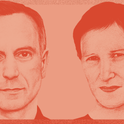A loan from a microfinance company enabled this tailor in Hyderabad to set up his own shop
Poor Economics: A Radical Rethinking of the Way to Fight Global Poverty
by Abhijit Banerjee and Esther Duflo, (PublicAffairs, £15.99)
Abhijit Banerjee and Esther Duflo want to reduce poverty. That goal is common—what distinguishes the work of these young economists, both at MIT, is their methods. They aim to inject scientific evidence into policy deliberation, and advance the debate with conclusions that can be widely agreed on while not being truisms.
The authors have assembled evidence from hundreds of randomised control trials, which test anti-poverty measures (for example, whether insecticide-treated bed nets should be sold or given away) in the same way that trials are used in medicine to test the effectiveness of new drugs. The data provide no grand universal answer to poverty. There is, however, “a body of knowledge that grows out of each specific answer and the understanding that goes into those answers that give us the best shot at, one day, ending poverty.”
Banerjee and Duflo stress that “the debate cannot be solved in the abstract.” Poverty is a more complex phenomenon than is captured in grand theories. The experts they criticise stand on both wings of the argument. These include William Easterly, who believes that markets and incentives will allow the poor to better themselves; and Jeffrey Sachs, who believes that market solutions will not work for those who are caught in what economists call a “poverty trap,” in which poor people need significant capital to earn enough to escape from poverty. Sachs argues that a big initial investment is needed to overcome disadvantage.
Campaigners against poverty almost all accept Sachs’s premise that there are poverty traps. Banerjee and Duflo offer a striking counterargument, rebutting the notion that hunger can lead to this kind of trap. The merit of their empirical approach is that they can substantiate their scepticism. They demonstrate that calorie consumption per head in India has declined in the last 25 years despite the country’s rapid economic growth. The reason seems to be that very poor people do not typically seek to maximise food consumption when they grow richer: instead, they buy food that tastes better. The seemingly obvious hypothesis that better nutrition leads to prosperity is not always true. The modern world, argue Banerjee and Duflo, “is for the most part too rich for the occasional lack of food to be a big part of the story of the persistence of poverty on a large scale.”
This view is heterodox, but it is founded on observation rather than ideology. And it is impossible to fit the authors’ thesis into the conventional mould of debate. The same attention to research informs the book’s wider conclusions. It makes a convincing case for intervention to mitigate global poverty. But intervention needs to be crafted around the ways that poor people cope with poverty.
Debates on poverty are usually framed by differing philosophical positions: states versus markets, open trade versus protectionism, aid as against self-reliance. Banerjee and Duflo took the novel approach of asking the opinions and studying the behaviour of the poor. Some markets are missing for the poor, or the price structure penalises them. The authors conclude that “optimism and hope can make all the difference.” The poor need the sense of security derived from knowing that some of their long-term goals are attainable. There are ways of instilling this knowledge through modest measures such as microcredit, better education and a minimum income. Disclaiming sweeping conclusions, the authors maintain that small-scale changes in governance can be advanced without radically changing political structures.
It is a powerful argument, and a convincing demonstration that big effects can flow from apparently small changes. And it would be unfair to fault the authors for devoting little space to macroeconomics when their argument is to show how poor people’s lives can be improved with micro reforms. But it is a big omission nonetheless. Bad policy by governments and donors can have ruinous effects. The history of official development assistance is littered with them. In Tanzania, Julius Nyerere’s policies of collectivisation of agriculture caused income per head to fall by an average 0.3 per cent a year from 1965-85. Nyerere could not have done this without World Bank lending for grandiose and fantastic schemes. Easterly has noted that donors committed $2bn over 20 years into road-building programmes in Tanzania, yet the roads deteriorated because they were not maintained once built.
External aid can be a force for development by increasing productive capacity and stimulating growth, but it also has the capacity to do great harm. The provision of microcredit and other small-scale reforms will be overwhelmed if policies are wrong and if external aid drives out private finance rather than supplementing it. Micro measures would not deal with, say, the recent cholera epidemic in Zimbabwe. Change requires the overthrow of the tyrant who turned a resource-rich country into a state of penury, disease and oppression.
Banerjee and Duflo’s work is an important contribution to a debate of immense economic and ethical significance. But it is a partial one, and the limits of their approach show. In their eagerness to avoid jargon and stress practicality, the authors have a tendency to tweeness (“intestinal worms might be the last subject you want to bring up on a hot date”). Good data are not enough, either for poverty reduction or a readable narrative.
Poor Economics: A Radical Rethinking of the Way to Fight Global Poverty
by Abhijit Banerjee and Esther Duflo, (PublicAffairs, £15.99)
Abhijit Banerjee and Esther Duflo want to reduce poverty. That goal is common—what distinguishes the work of these young economists, both at MIT, is their methods. They aim to inject scientific evidence into policy deliberation, and advance the debate with conclusions that can be widely agreed on while not being truisms.
The authors have assembled evidence from hundreds of randomised control trials, which test anti-poverty measures (for example, whether insecticide-treated bed nets should be sold or given away) in the same way that trials are used in medicine to test the effectiveness of new drugs. The data provide no grand universal answer to poverty. There is, however, “a body of knowledge that grows out of each specific answer and the understanding that goes into those answers that give us the best shot at, one day, ending poverty.”
Banerjee and Duflo stress that “the debate cannot be solved in the abstract.” Poverty is a more complex phenomenon than is captured in grand theories. The experts they criticise stand on both wings of the argument. These include William Easterly, who believes that markets and incentives will allow the poor to better themselves; and Jeffrey Sachs, who believes that market solutions will not work for those who are caught in what economists call a “poverty trap,” in which poor people need significant capital to earn enough to escape from poverty. Sachs argues that a big initial investment is needed to overcome disadvantage.
Campaigners against poverty almost all accept Sachs’s premise that there are poverty traps. Banerjee and Duflo offer a striking counterargument, rebutting the notion that hunger can lead to this kind of trap. The merit of their empirical approach is that they can substantiate their scepticism. They demonstrate that calorie consumption per head in India has declined in the last 25 years despite the country’s rapid economic growth. The reason seems to be that very poor people do not typically seek to maximise food consumption when they grow richer: instead, they buy food that tastes better. The seemingly obvious hypothesis that better nutrition leads to prosperity is not always true. The modern world, argue Banerjee and Duflo, “is for the most part too rich for the occasional lack of food to be a big part of the story of the persistence of poverty on a large scale.”
This view is heterodox, but it is founded on observation rather than ideology. And it is impossible to fit the authors’ thesis into the conventional mould of debate. The same attention to research informs the book’s wider conclusions. It makes a convincing case for intervention to mitigate global poverty. But intervention needs to be crafted around the ways that poor people cope with poverty.
Debates on poverty are usually framed by differing philosophical positions: states versus markets, open trade versus protectionism, aid as against self-reliance. Banerjee and Duflo took the novel approach of asking the opinions and studying the behaviour of the poor. Some markets are missing for the poor, or the price structure penalises them. The authors conclude that “optimism and hope can make all the difference.” The poor need the sense of security derived from knowing that some of their long-term goals are attainable. There are ways of instilling this knowledge through modest measures such as microcredit, better education and a minimum income. Disclaiming sweeping conclusions, the authors maintain that small-scale changes in governance can be advanced without radically changing political structures.
It is a powerful argument, and a convincing demonstration that big effects can flow from apparently small changes. And it would be unfair to fault the authors for devoting little space to macroeconomics when their argument is to show how poor people’s lives can be improved with micro reforms. But it is a big omission nonetheless. Bad policy by governments and donors can have ruinous effects. The history of official development assistance is littered with them. In Tanzania, Julius Nyerere’s policies of collectivisation of agriculture caused income per head to fall by an average 0.3 per cent a year from 1965-85. Nyerere could not have done this without World Bank lending for grandiose and fantastic schemes. Easterly has noted that donors committed $2bn over 20 years into road-building programmes in Tanzania, yet the roads deteriorated because they were not maintained once built.
External aid can be a force for development by increasing productive capacity and stimulating growth, but it also has the capacity to do great harm. The provision of microcredit and other small-scale reforms will be overwhelmed if policies are wrong and if external aid drives out private finance rather than supplementing it. Micro measures would not deal with, say, the recent cholera epidemic in Zimbabwe. Change requires the overthrow of the tyrant who turned a resource-rich country into a state of penury, disease and oppression.
Banerjee and Duflo’s work is an important contribution to a debate of immense economic and ethical significance. But it is a partial one, and the limits of their approach show. In their eagerness to avoid jargon and stress practicality, the authors have a tendency to tweeness (“intestinal worms might be the last subject you want to bring up on a hot date”). Good data are not enough, either for poverty reduction or a readable narrative.












